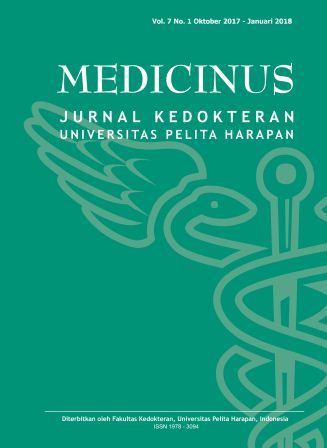Sensitivitas Dan Spesifitas Tes Provokatif Dan Pengukuran Latensi H Refleks Pada Sindrom Piriformis
DOI:
https://doi.org/10.19166/med.v7i1.1445Abstract
Background Piriformis syndrome (PS) is one causes of buttock and hip pain which is caused by pressure of sciatic nerves on piriformis muscle. PS is sometime misdiagnosed because of similar clinical signs and symptoms with other lower back pain diagnosis such as Hernia Nucleus Pulposus (HNP), Sacroiliac joint pain, facet joint pain. Gold standard diagnosis of PS is diagnostic block injection. However, provocative test and prolonged H reflex on EMG might be also standard diagnostic of PS.
Aim Understand the sensitivity and specificity of provocative test and prolonged H reflex to diagnose PS.
Method 72 patients with suspected PS who came to Neurology OPD in period of August- December 2017 were testing with physical examination (provocative test) and Electromyography test of H reflex. PS is diagnosed by positive diagnostic block injection. Data was proceeded with SPSS 20 version.
Result 72 patients with buttock pain which diagnosed with PS were dominated by female gender than male with ratio 1:3 with housewives as majority of work. Most age groups were 48.6% elderly (age more than 60 years old). Provocative tests result of Freiberg, FAIR, Beatty, Pace Sign, Hip Abduction sensitivity were 52.30; 66.15; 53.84; 46.15; 55.32 and specificity were 100; 42.85; 71.42; 71.42; 57.14. While sensitivity and specificity of prolonged H reflex more than 1.86 msec were 69.23 and 28.59. Combination of 3 provocative tests (FAIR, Freiberg and Beatty) resulted highest sensitivity and specificity in this study as 71.42 and 100.
Conclusion Provocative test and prolong H reflex can be supported diagnosis of PS. However both tests might not be comparable yet than diagnostic block injection as gold standard of PS. Combination of provocative test increased the sensitivity and specificity of provocative test than single test only.
Downloads
Published
How to Cite
Issue
Section
License
Copyright (c) 2019 Yusak Siahaan, Vonny Gunawan, Evelyn Suryawijaya, Pamela Tiffani

This work is licensed under a Creative Commons Attribution-ShareAlike 4.0 International License.
Authors who publish with this journal agree to the following terms:
1) Authors retain copyright and grant the journal right of first publication with the work simultaneously licensed under a Creative Commons Attribution License (CC-BY-SA 4.0) that allows others to share the work with an acknowledgement of the work's authorship and initial publication in this journal.
2) Authors are able to enter into separate, additional contractual arrangements for the non-exclusive distribution of the journal's published version of the work (e.g., post it to an institutional repository or publish it in a book), with an acknowledgement of its initial publication in this journal.
3) Authors are permitted and encouraged to post their work online (e.g., in institutional repositories or on their website). The final published PDF should be used and bibliographic details that credit the publication in this journal should be included.





